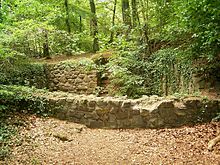Holthausen (Hagen)
Holthausen is a district of the urban district of Hagen in the eastern Ruhr area in the Hohenlimburg district .
The district located in a side valley of the Lenne is traversed by the Holthauser Bach . The community of Holthausen was incorporated into the city of Hagen on August 1, 1929.
Holthausen was first mentioned in 1229 as Holthusen in the goods and income register of the women's convent and later the noble women's monastery Herdecke . Around this time, the Raffenburg was built near the mouth of the Lenne as a territorial fortification for the Archbishops of Cologne , who were also dukes of Westphalia. However, the castle was destroyed again in 1288.

On the ridge of the Hünenpforte and also on the ground of the district of Holthausen are the ruins of the Rücklenburg . The small fortification with a few houses, ramparts and moats as well as a tower-like building existed at the same time as the Raffenburg and was probably destroyed along with it.
Between the Rücklenburg and the Raffenburg there was a medieval settlement in the "Alte Statt" corridor. Archaeological evidence suggests that this settlement was related to the Raffenburg and the Rücklenburg. Fire residues indicate destruction by fire.
Holthausen belonged to the peasantry Haßley and in the parish and court Hagen to County of Mark . In the treasure book of Grafschaft Mark from 1486, 11 taxable farm owners are named in the Burschop Hasselen with a tax between 1 and 8 gold guilders .
In 2004, skeletal remains were discovered by numerous people in a very narrow leaf cave near Holthausen that led deep into the rock . According to scientific research, they come from the early Mesolithic and the Neolithic . Both the remains of the Mesolithic and Neolithic people are among the most outstanding archaeological finds in Europe .
The finds from the Mesolithic are around 10,700 years old and thus represent the oldest remains of anatomically modern people in the Ruhr area and Westphalia . The Neolithic skeletal remains, including the almost completely preserved skeleton of a 17 to 22-year-old woman, are among the few known burials of the Michelsberg culture in Europe.
Web links
Individual evidence
- ↑ Stephanie Reekers: The regional development of the districts and communities of Westphalia 1817-1967 . Aschendorff, Münster Westfalen 1977, ISBN 3-402-05875-8 , p. 248 .
- ^ Ralf Blank / Stephanie Marra / Gerhard E. Solbach: Hagen - history of a large city and its region , Klartext Verlag, Essen 2008, page 89
- ^ A. Meister (Ed.): Die Grafschaft Mark , Dortmund 1909, page 51
Coordinates: 51 ° 21 ' N , 7 ° 33' E

